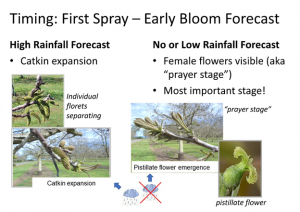Luke Milliron, UCCE Farm Advisor Butte, Tehama and Glenn Counties; James E. Adaskaveg, Department of Microbiology and Plant Pathology, UC Riverside
For any pest or disease like walnut blight that requires pesticide application to keep in check, there are four key pillars to successful management: timing, material, rate, and coverage. Below are the latest updates for managing walnut blight in 2022.
Timing: Typically, the timing of the first walnut blight spray depends on the orchard’s disease history and forecast weather. However, following minimal spring rainfall, and therefore minimal blight pressure in 2020 and 2021, growers have the advantage of entering the 2022 season with very low blight inoculum. Therefore, in 2022, timing of your first walnut blight spray should depend solely on forecast weather. If there is high rainfall forecast, consider spraying as early as bud break or catkin emergence (figure 1) and then following up with a second spray 7-10 days later. If there is little or no rain forecast, consider the timing of 20% prayer stage. In the absence of rain at bloom, avoiding a spray all together to cut expenses, may be a risky proposition. Even a brief dew can be enough to start the disease cycle. Also, this prayer stage timing helps keep the disease’s inoculum in check, and this timing may also be useful in providing a free ride for a foliar zinc nutrition spray.

Figure 1. Timing of first blight spray when inoculum is very low (e.g. 2022 bloom) is based on forecast weather. If there is high rainfall forecast spray during catkin expansion. If there is no or low rainfall forecast wait to spray at “prayer stage” (the single most effective timing). Photos and figure by Jim Adaskaveg (UC Riverside).
Material & Rate: The pairing of copper and mancozeb remain the cornerstone of a conventional walnut blight disease management program. This combination is not only highly efficacious, but it also has a greater persistence or shelf-life once applied, compared to other combinations. Jim Adaskaveg has found that applying a mix of a liquid and a fixed copper provides the best of both worlds – an immediate source of copper ions and a residue reservoir of copper for persistence during and after rain. Although copper has had varying levels of resistance between walnut orchards for decades now, to-date mancozeb resistance has not developed. However, high resistance to mancozeb, reported for a disease genetically related to walnut blight in Florida, serves as a warning that mancozeb’s effectiveness must be protected. Despite the European Commission’s decision to not renew mancozeb, this currently only impacts famers in the EU, California farms can continue to use mancozeb at this time.
Rotating modes of action to combat the development of pesticide resistance is a pillar of integrated pest management. With the registration of Kasugamycin (tradename Kasumin) this became possible for the first time in 2018. Kasumin is applied at 64 fl oz/ac with a minimum of 100 gallons of water by ground or 20 gallons by air (no off-label use rates). In 2020, the Kasumin label was updated from a maximum of two applications per season to four (with up to two sequential applications before rotation to other modes of action). The newest available blight treatment is Dodine (tradename Syllit). It was registered in 2021, but available for the first time in the 2022 season. Syllit should be used in mixture rotations, either in combination with copper or kasugamycin (i.e. it is a mancozeb substitute). Syllit should be used at a rate of 16 oz/ac (do not exceed). Growers can now use four pesticides in several two-part combinations to rotate through different modes of action that provide good blight control (figure 2). Rotation is critical to preserving the success of copper and mancozeb as the cornerstone of conventional blight management.

Figure 2. An example of walnut blight material rotation in the Sacramento Valley. In this high rainfall example, the grower first sprays at catkin expansion and with continued forecast rain transitioned to each subsequent two-part mix every 7 to 10 days. The relative efficacy of each of these two-part combinations is detailed in UC IPM’s fungicide and bactericide efficacy tables (ipm.ucanr.edu/PDF/PMG/fungicideefficacytiming.pdf). This example and the fungicide and bactericide efficacy tables are not pesticide recommendations. Always follow the label, the label is law.
Coverage: Before it’s time for the first spray to go out, make sure your sprayer is calibrated for good spray coverage. Coverage is key to blight management because if part of the foliage is not covered, it’s not protected. In addition to calibration, avoiding half sprays is critical to achieving good coverage. Half sprays mean you’re only half protected. In addition, they are NOT permitted when using Kasumin.
These four pillars of pesticide disease control are only one component of integrated management. See our article on walnut blight management to learn more about the walnut blight disease cycle, details of Kasugamycin use, and the efforts to breed walnut trees for greater blight resistance.


Leave a Reply